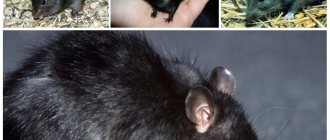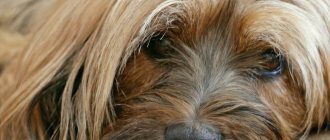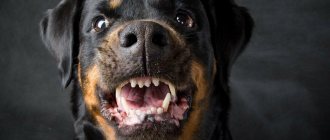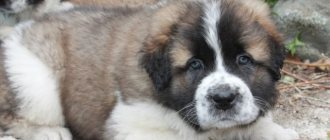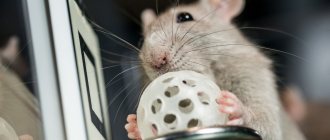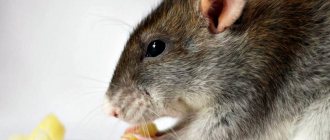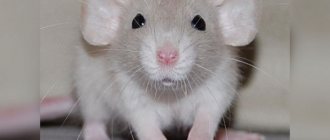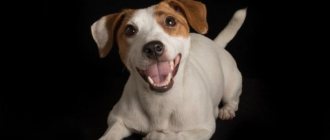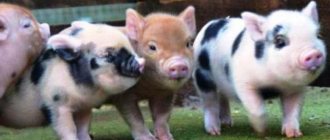Overview of varieties of decorative rats
Domestic rats differ from each other in body type and coat type. There are no breeds as such among these rodents. Among them there are varieties, each of which has a certain appearance.
A parental pair cannot be guaranteed to pass on characteristics characteristic of a variety to its offspring. For example, two rats with standard ears can give birth to a baby Dumbo rat.
Decorative rats have their own subspecies and breeds
Thoroughbred rats are divided according to certain characteristics:
- Body type (standard and dumbo);
- Coat type (standard, wavy, sphinx, rex, downy, half sphinx, velor, satin);
- Color (divided into sections: uniform, silver, ticked, marked, combined, husky, non-standard colors);
- Markings (presence and location of white on the main color);
You can buy a baby rat at a pet store or through an advertisement for a price starting from 100 rubles. A rodent from a nursery may cost more (300 – 1500 rubles), but the health guarantee is higher. In the nursery you can purchase a pet for participation in exhibitions and breeding work.
The decorative rat originated from the wild gray rat - pasyuk.
During the process of domestication, the animals changed their head shape, ear size, coat color and type, temperament and attitude towards humans. A domestic rat is the same pasyuk, only in a domesticated form.
Today there is a Standard for varieties of ornamental rats, which Russian and foreign breeders are working on.
Features of the most popular breeds of domestic rats
The standard breed rat is widely used as a pet; it has a long tail, black eyes, round shape, and regular shaped ears located at the top of the animal's head. Representatives of this breed can reach a weight of up to 0.5 kg. Males are larger than female representatives of the species.
In general, the rat does not require special care. The color of the fur may vary, the animal is completely covered with hairs. This type of rat is suitable for beginner rodent lovers.
The advantage is that it is not difficult to buy a standard decorative rat; you just need to contact trusted breeders and trustworthy sellers so that the rat is not the result of close inbreeding, otherwise there is a high risk of frequent pet illnesses and early death.
If the owner does not have any preferences in color, coat length, or body structure, then you can safely have a standard breed rat as a friend.
The Dumbo rat looks very funny and charming. At the market, representatives of this species of rat immediately won the love of buyers and animal lovers. The main feature of these rats is that their ears are larger and located lower than those of other rats, on the sides of the head.
The body shape of Dumbo rats is pear-shaped. You should know that the value of rats of this breed is measured by the size of their ears; the larger they are, the more valuable.
The main difficulty in getting a Dumbo rat will be purchasing the animal; representatives of this species are practically not found in a regular pet store. Therefore, you will have to find a suitable breeder.
Little rat pups do not yet have pronounced signs, so contact trusted breeders with a good reputation to avoid deception.
For those owners who do not like the long, hairless tail of a rat, a special tailless breed was bred. Otherwise, these rats require normal care, but purchasing a pet of this species will be difficult.
“husky” and “mosaic” rat breeds differ from their other counterparts in their coat color. Huskies have a two-color coat color: white and gray, often have a symmetrical and regular pattern, and their eyes differ in shades of red.
“Mosaic” rats are tri-colored and are the rarest because they do not genetically pass on the color to their offspring.
Body type
Standard
Decorative rat of the standard breed
The animal has a proportional, flexible, plastic physique without signs of fragility. Females are somewhat lighter and look more graceful. The length of the animal is up to 26 cm (to the tip of the tail). The length of the tail is proportional to the length of the body (including the head).
The eyes are large, round and shiny. The eye color is in harmony with the coat color according to the standard. Small ears are located at the top of the head and are larger in size than the Pasyuk's ears. The head is proportional to the body, of sufficient width.
Coat type and color are determined by the general Standard.
The coat fits well and is shiny. The paws and tail are covered with short hair. Light-colored rats have short, velvety fur on their ears.
The antennae are oblong and proportionally located on the cheeks; above the eyes they are shorter and in smaller numbers. In rodents with other types of hair (rexes, sphinxes, etc.), the whiskers may be short, curled and sparse.
Dumbo
Decorative rats Dumbo
Dumbo differs from the standard in the shape of his ear and skull. Dumbo's ears are lowered and are approximately at eye level. The ear is wider and more rounded than the standard one.
The name "dambo" translates as "baby elephant". That is, the ears resemble the ear of a baby elephant.
The ear should be as open as possible. Folds are not allowed. The dumbo ear has two shapes: open and “tulip”, when the upper edge is slightly directed downwards.
The coat type and coat color correspond to the descriptions in the general Standard.
The Dumbo's skull is slightly wider than that of the standard. Due to the position of the ears, the head of this variety looks wide and flat. The back of the dumbo's head has a barely noticeable convexity.
Classification of rats depending on body type
Based on body type, domestic rats are divided into main groups:
- Standard. Pets have a proportional build. They are slender and quite flexible. The size of the tail of decorative rats is almost equal in size to the length of the entire body with head. The shape of the tail tapers from the base to the tip. The eyes of this breed of pet are round and large. The ears are located on top of the head and are proportional in size. The fur of such animals shines slightly and is located throughout the body. Standard rats are the largest ornamental rodents. Their weight ranges from 300-500 grams, directly depending on the animal’s nutrition, as well as its gender. Females are more mobile. Their size from nose to tail reaches about 25 centimeters. Males may be larger.
- "Dumbo" rats. They originated in California. They were brought out in 1991. A distinctive feature of these animals is the structure and location of the ears. In the Dumbo breed they are located lower, not at the very top of the head. The shape is also different. The ears look rounder and wider. In these rats, they can be completely open, and also have a slightly bent upper edge. Some pets have a slightly protruding nape. The body shape of this type of animal widens slightly at the back, resembling a pear. However, the body parameters are smaller than other breeds.
- Tailless rats. The name of these rodents speaks for itself. These animals are characterized by the absence of a tail. Moreover, these animals can be either with or without fur, wavy and curly. The color of the coat is also completely varied. The shape of the body is mainly pear-shaped.
Coat type
Standard
The coat is smooth, shiny, tight-fitting; the mustache is long and dense. The paws and tail are covered with fine fur. The ears have short velvet fur. The undercoat is well formed.
Curly (rex)
Curly rat (Rex)
The hair is dense, dense and forms curls. On the belly the hair is straighter. The amount of hair is less than the standard coat type, or it is absent. The hair is inferior in shine to the standard type.
Tactilely, the hair is slightly coarser than standard, without signs of brittleness or stiffness. The mustache is short and curled.
Wavy (teddy, corduroy)
Wavy Rat Corduroy Thick
, soft, even coat, more wavy than curly. Visually, the coat is slightly disheveled, but looks well-groomed. There is a thick undercoat, but the awns are practically absent. The mustache is of good length, with a slight wave.
Sphinx
Decorative rat Sphynx
The skin of the Sphynx is almost completely bald; she is healthy, bright and soft. In some areas of the body (on the muzzle, limbs and groin area) pubescence is allowed. There may be folds. The mustache is short and curly.
Downy
The body of the animal is covered with short, thin, soft fluff. On the face and lower body the hair is thicker and longer. There is no guard hair. The skin is pleasant to the touch, velvety. The antennae are slightly curled downwards. Bare areas of the body are not allowed.
Half Phinx (double rex) outside the standard
Decorative rat of the Double Rex breed.
The fur is short and harsh. The mustache is short and curls tightly. Double Rex has two types:
- The rat has hairless and hairy areas of the body. They may change over time, i.e. bare skin becomes overgrown, and pubescent skin becomes bald.
- The rodent has short hair only on the face, tail, legs and belly.
Satin (satin, longhair)
Satin Rat
The coat is thin, silky, longer than usual. The white color has a yellowish tint. The impression of “shining” wool.
Velor
There is very little or no guard hair. The coat is shorter than that of the Rex, curled or crimped. The mustache curls tightly.
Tailless rats
As the name suggests, these rats do not have tails. This breed is the result of a mutation. The first tailless rat was obtained by an amateur in 1983. This variety has a slightly different body shape than standard rats; the body is pear-shaped. Representatives of this breed should not even have the rudiment of a tail.
Tailless rats are not hindered by the absence of a tail.
Description of colors by section
Homogeneous
Black decorative rat
The hair is colored uniformly in one tone. The exception is the ash-blue color. The body has a uniform color without spots or ticking.
- Black;
- Blue (Russian blue, smoky);
- White;
- Champagne;
- Blue;
- Platinum;
- Russian silver and other solid colors.
Ticked
Agouti Rat
The body has a single color. Part of the hair is colored unevenly, in two or more colors (with belts). Among these zone-colored hairs are hairs with a uniform color.
- Agouti (platinum, Russian blue, blue);
- Faun;
- Cinnamon;
- Amber;
- Pearl (cinnamon, blue);
- Topaz.
Silver
Silver-blue rat
This section is characterized by alternating silver hair with hairs of a different color (uniform or ticked). The color is bright and uniform.
- Silver-mink;
- Silver - blue;
- Silver-black;
Combined
Siamese Dumbo Rats
The color consists of several colors (except white), which are arranged in accordance with the norms prescribed by the Standard.
- Siamese (blue, Russian blue, mink, black-eyed Siamese);
- Himalayan (blue or with black eyes);
- Burmese (Russian, wheat, sable, blue).
Marked
Decorative rat with marked color
Marking is a pattern, i.e. combination of white color with colored areas.
- Irish;
- Anglo – Irish;
- Raincoat (European, with blaze);
- Hood (or shortened hood);
- Cap (or cap with a train);
- Spotted - raincoat (or spotted);
- Train (or train with blaze);
- Masked;
Blaze is a white wedge-shaped spot on the face.
Husky (blooming)
Decorative Husky Rat
This type combines blaze (in a coat or train) with a perennial base color. Symmetry and contrast are important components for this marking. Cubs up to 3 weeks of age have a uniform color with a blaze, but later the husky's coat begins to turn silver.
- Raincoat;
- Daisy chain;
Non-standard colors
These colors are not recognized by the Rat Club.
- Dove;
- Devil;
- Black devil
An animal with these colors receives marks at the exhibition, but does not receive titles.
Odd-eyed
White rat with different eye colors.
Coat color - any. One eye is pink or red, the other is black or ruby.
How to care for a white rodent?
The cage - the place where the albino lives - must be kept clean, regularly removing excrement and food debris. This will protect the animal and the cage from an unpleasant odor, and will also keep the rat’s fur clean.
A retractable tray is the best solution for cage care. By pulling it out and changing the filler, you can easily ensure cage hygiene.
Being a collective and sociable animal, this animal needs the attention of its owner. Therefore, it is better to have two or more animals at once. Of course, if you do not plan to breed offspring, you should give preference to same-sex rodents.
The fur of a white rat requires constant care. It needs to be combed regularly using a brush, and the rodent must also be provided with regular water treatments. If the white fur turns yellow, this means that the rodent may have become ill and cannot care for itself - a reason to contact a veterinarian.
The cage with the white animal should be placed in a place where direct sunlight will not be directed at it, as the pet is afraid of them.
Human vision is 30 times better than that of an ordinary rat. In turn, the vision of an ordinary rat is 2 times better than that of an albino rat. The animal sees its surroundings as blurry, so the space around it needs to be protected. Care must be taken to ensure that the rodent does not bump into sharp objects or fall from great heights. The same applies to other domestic animals - predators.
Other varieties
Pasyuk
This is a fairly large rodent, weighing 250-600 grams. Unlike the domesticated form, the pasyuk has a convex forehead and well-defined brow ridges. The pasyuk's tail is thick and its length is shorter than the body. The ears are relatively small. Pasyuk is a homogeneous standard agouti.
Rat Pasyuk
Pasyukov can be kept at home, including together with a domesticated rat. Some nurseries infuse the blood of wild gray rats into domestic animals or breed only pasyuki.
Pasyuk retained most of his natural instincts. He easily accepts new experiences, thinks quickly and survives in the wild.
Domestic rats: disease information
The lifespan of tame rodents is influenced by various factors:
- Heredity;
- Quality of care;
- Nutritional balance;
- Availability of regular medical care.
Domesticated animals can live for about three years, but some rat breeders have had their pets live up to seven years. The increase in the life of rodents is due to the fact that they do not have contact with many pathogens and viruses, insects that carry helminth eggs and typhus.
In order for pets to live as long as possible, they need to be provided with optimal living conditions, proper nutrition, and physical activity. Animal health is greatly influenced by their psychological state. It was observed that individuals that were frequently exposed to stressful situations were susceptible to protozoal infectious diseases and Tyzzer's disease. With an unbalanced high-calorie diet, rodents often develop a tumor of the pituitary gland, and when exposed to conditions with low humidity and drafts, tail necrosis has been observed.
Description
The domestic decorative rat is a small animal. The male weighs about 600 grams, the female is twice as small - 300 grams. Body length is from 8 to 25 centimeters. The build and shape of the muzzle depend on the breed, but most often they have an elongated nose. The body is covered with fur, the density of which also depends on the breed, the tail is almost bare, up to 18 centimeters long, and the legs are short. The color is often monochromatic - red, white, black, gray.
At the same time, among some breeds there are individuals with two-color coats. The color of the eyes also depends on the color, for example, white rats have pink eyes, gray rats have black eyes.
Rat character
This phrase sounds intimidating and even a little unpleasant. But in reality, the domestic rat (owner reviews indicate this) has an excellent character and a number of advantages that make this rodent a favorite pet in many families.
A rat, as a pet, is not inferior to a cat in terms of cleanliness. She also washes her face frequently. If the cage is cleaned properly and in a timely manner, there will be no unpleasant odor in the house. Keeping a pet rat can be combined with training this animal. Don’t be surprised, but these animals, like dogs, can perform various commands - “stand”, “lie down”, “sit” and others. A treat will help you achieve results.
We invite you to read: Vladimir heavy truck - information about the breed, its description, breeding and character
We can say that rats are omnivores. But in this article we will tell you what you should not feed these rodents. It is very interesting to watch these animals in a well-equipped cage: with a wheel, all kinds of rings and pipes. Rats deftly use their tails and their prehensile paws.
